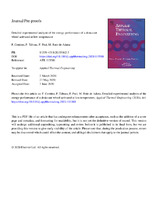Detailed experimental analysis of the energy performance of a desiccant wheel activated at low temperature
Autor
Comino Montilla, Francisco
Táboas, Francisco
Peci López, Fernando
Ruiz de Adana, Manuel
Editor
ElsevierFecha
2020Materia
Desiccant wheel performanceRegeneration efficiency
Desiccant material temperature
Low temperature activated systems
METS:
Mostrar el registro METSPREMIS:
Mostrar el registro PREMISMetadatos
Mostrar el registro completo del ítemResumen
Desiccant dehumidification systems, such as those using desiccant wheels (DW), are an interesting alternative toconventional dehumidification systems based on vapor-compression cycles. The aim of this work was to obtainexperimentally the performance of a DW activated at low temperature along the heat and mass transfer surfaceunder different working conditions. The air temperature and humidity were measured at 32 different points, inorder to analyse the performance of the DW at different circular sectors of the rotor.The results showed that the surface temperatures of the desiccant material on the process side decreasedwhen the rotation speed decreased. Conversely, the surface temperatures of the desiccant material on the re-generation side increased when the rotation speed decreased.The minimum outlet process air temperatures and the maximum process air dehumidification were obtainedin the circular sector closest to the regeneration side. In this circular sector the highest efficiency values wereobtained. The number of circular sectors where the highest efficiency values were obtained increased when therotation speed or airflow rates increased. Using these data, the wheel control strategy could be designed toincrease the dehumidification capacity.

